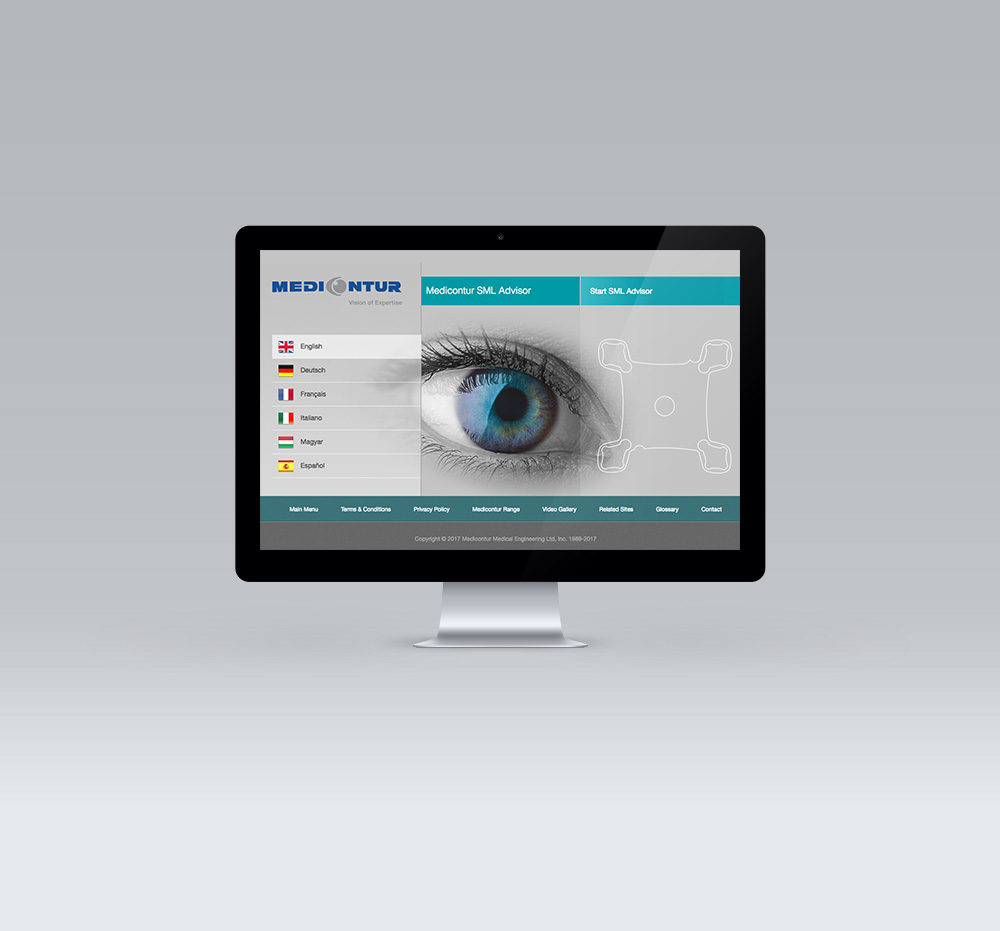How to choose a suitable patient?
KEY: PRECISE INDICATION AND STEP BY STEP EXAMINATION
Indications
The SML is recommended for motivated patients:
-
- With dry AMD and near vision difficulties.
- With other stable retinal conditions
– Diabetic retinopathy, myopic retinopathy
– Other hereditary retinal diseases proven by OCT
*Please contact us for further information - Who are pseudophakic or candidates for cataract surgery.
- Who show sufficient near vision improvement on near vision tests performed with +2.5D at 40cm and with +6.0D at 15 cm.
- BCDVA
– equal or less than 0.32 decimal ETDRS ( equivalent to 6/18)
– equal or more than 0.1 decimal ETDRS charts ( equivalent to 6/60)
*Please note that the patient may still benefit from the SML if outside of the above
Please contact Medicontur to find out more.
Examine and select suitable patients:
Preoperative CNVA needs to be examined as follows:
- Patients read at a distance of 40 cm with an addition of +2.5D placed over their distance prescription eyeglasses (examination A) and then at a distance of 15 cm with an addition of +6.0D placed over their distance prescription eyeglasses (examination b).
- The patient is a good candidate for the SML implantation if there is 3 or more lines of improvement between examination A and B.
- The patient may still benefit from SML implantation in case of 1 or 2 lines of improvement
(please consult Medicontur or your local provider)
IMPORTANT:
- Based on these near vision tests, we can estimate the likely near visual acuity of the patients after implantation of the SML.
- It is important to communicate this with the patients and to set realistic expectations for them.
- Each eye should be tested monocularly for distance (UCDVA & BCDVA) and near visual acuity.
- The implanted eye should be the better seeing one.

contraindications
- Active neovascular AMD/maculopathy
- Active iris neovascularisation
- Zonulopathy
- Subluxation of the primary IOL
- Shallow pseudophakic ACD (< 2.8 mm; from endothel)
- Narrow angle, i.e. < Schaefer grade 2
- Pigment dispersion syndrome
- Uveitis
- Pupillary abnormalities
- Aphakia
- Progressive glaucoma
- Corneal diseases involving central cornea
The SML Advisor

This tool has been designed for your convenience and support:
- Determine if your patient is suitable for SML implantation.
- Determine the more suitable eye for implantation.
- Estimate the extent of visual acuity improvement.
- Generate a pdf and/or print-out including detailed patient data and the results of your evaluation, which you can then add to the patient’s records.
- If your patient is evaluated suitable for the implantation, conveniently send the order form directly to our scientific team and your local provider.
Easy to use
Time saving
CAUTION:
Even the best online tools cannot substitute accurate measurements and the opinion of a specialist ophthalmologist.
If you have any further questions please contact us at scientific@medicontur.hu
IMPLANTATION
Step by step guide
Medicontur Scharioth Macula Lens
Implantation
Implantation in the ciliary sulcus is performed following cataract surgery.
Monocular implantation in the better-seeing eye.
Easy implantation using a standard IOL injector through a 2.2 mm incision.
No extensive training is required – minimal learning curve.
Additional points to remember:
- Interval between OCT & surgery should not exceed 10 days
- Interval between cataract surgery and the SML implantation should be at least one month
- Clear lens extraction and intracapsular IOL & SML implantation in one session is possible, though currently not recommended by Medicontur
POST-OPERATIVE
KEY: POST-SURGICAL TRAINING IS PARAMOUNT FOR PATIENT SATISFACTION
TRAINING AFTER SURGERY
Patients need to practice performing near vision reading tasks without the use of magnifying aids. This should be performed 2-3 times a day for at least 20 minutes at a time during the first 4-8 weeks following SML implantation.
- The eye without the SML implantation may need to be covered during the first few days after SML implantation when reading.
- The reading material needs to be held at approximately 15–18 cm from the patient’s eye. Good lighting conditions and high contrast reading materials are recommended.
- A dedicated and experienced low vision expert is necessary for achieving optimal results after surgery.
- The adaptation is quick: it usually takes 2-5 weeks after surgery.
READING DISTANCE IS APPROXIMATELY 15–18 cm (6”) FROM PATIENT’S EYE
Possible complications and recommendations
Complications are not common but may occur
- WET AMD development: So far there is NO clear evidence that intravitreal injection of anti-VGEF may prevent decompensation/development of wet AMD after the implantation of SML under dry & stable AMD conditions. For this reason the preventive use of anti-VGEF is currently not recommended by Medicontur.
- SD-OCT macula is recommended to be performed before surgery, ideally no more than 10 days before surgery to avoid hidden / developing wet AMD.
- Inflammatory reaction in the anterior chamber. Anti-inflammatory drugs like corticosteroids (for up to 3 weeks after surgery) and NSAIDs (for up to 2 months after surgery) are recommended.
- Far vision disturbances (halos, glares). We recommend sunglasses and if these are not effective, we recommend so called neutral Density Filter glasses. Pilocarpine can also be considered if sunglasses are not effective in reducing these symptoms.


